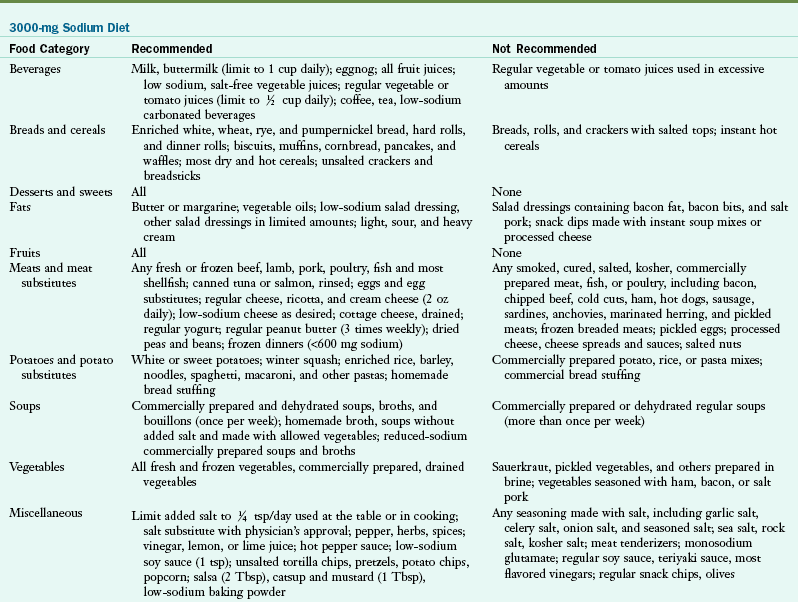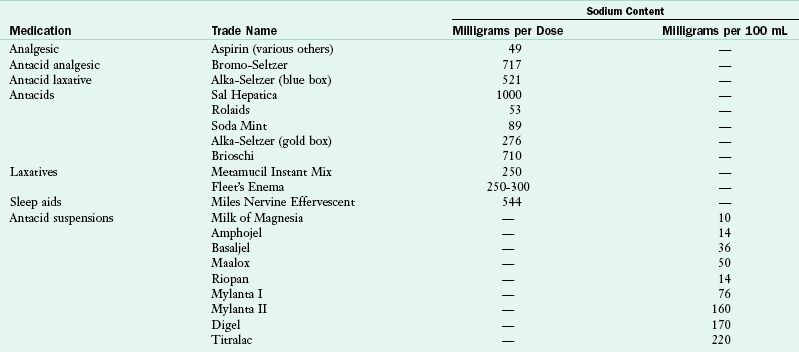Sodium-Restricted Diets
Sodium restriction is used in the management of essential hypertension and for cardiovascular disease, severe cardiac failure, impaired liver function, renal disease, and chronic renal failure. The goal of the sodium-restricted meal plan is to manage hypertension in sodium-sensitive persons and promote the loss of excess fluids in edema and ascites. Sodium is restricted to various degrees to meet the requirement.
Adequacy
Depending on individual food choices, sodium-restricted meal plans are adequate in all nutrients based on the Dietary Reference Intakes. When sodium is restricted to 1000 mg or less, a calcium supplement may be needed.
Special Considerations
A large volume of research has assessed the relationship of dietary sodium intake to prevention and treatment of high blood pressure. One result of this research is that sodium in combination with chloride (table salt) may aggravate hypertension is some people who are sensitive to salt. Numerous health agencies agree that sodium intake should be limited to 2.4 g (2400 mg) or less per day for healthy people. 1 tsp salt contains 2300 mg sodium.
A therapeutic sodium-restricted meal plan should be prescribed in terms of milligrams of sodium desired on a daily basis. The following are the commonly used levels of sodium restrictions:
No Added Salt (NAS): This is the least restrictive of the sodium-restricted diets. Table salt should not be used, and salt should be limited in cooking. When high-sodium foods such as smoked, cured, or dried meats and cheeses; condiments and seasonings, salted snacks, and canned and dried soups and bouillon are also limited, the NAS diet provides approximately 4000 mg of sodium daily.
3000 mg sodium (7.5 g NaCl or 130 mEq Na): This diet restricts foods and beverages that have been highly processed with sodium such as fast foods; salad dressings; soy sauce; salty snack foods; smoked, salted, and kosher meats; regular canned foods; pickled vegetables; luncheon meats; and commercially softened water. Up to  tsp salt per day may be used in cooking or at the table.
tsp salt per day may be used in cooking or at the table.
2000 mg sodium (5 g NaCl or 87 mEq Na): This diet eliminates processed and prepared foods and beverages that are high in sodium. Salt should not be used in cooking or at the table. Milk and milk products are limited to 16 oz daily. Only salt-free commercially prepared foods should be used.
1000 mg sodium (2.5 g NaCl or 45 mEq Na): Processed and prepared foods and beverages that are high in sodium are eliminated. Regular canned foods, many frozen foods, deli foods, fast foods, cheeses, margarines, and regular salad dressings are also eliminated (low-sodium or sodium-free versions should be substituted). Regular breads are limited to two servings/day. Milk and milk products are limited to 16 oz/day. Salt should not be used in cooking or at the table. Note: Most medical professionals no longer recommend eating patterns with less than 1000 mg sodium. In addition to being unpalatable, they are very restrictive and could result in nutritional deficiencies if followed for an extended period.
Guidelines for Sodium Restriction
• Obtain and evaluate a diet history before prescribing or instructing on a sodium restriction.
• Recommend salt substitutes containing potassium chloride only if approved by a physician. Salt-free seasoning products are readily available in most grocery stores and should be suggested instead.
• Instruct patients on reading the Nutrition Facts food label for sodium content of foods.
• Recommend potassium replacement if diuretics are used. If potassium intake from foods is not sufficient, potassium supplements may be necessary.
• Provide information on choosing low-sodium foods at restaurants.
• Recommend baked products, using sodium-free baking powder, potassium bicarbonate (instead of sodium bicarbonate or baking soda), and salt-free shortening in place of those containing sodium.
• Avoid obviously salted foods such as bouillon, soup and gravy bases, canned soups and stews; bread and rolls with salt toppings, salted crackers; salted nuts or popcorn, potato chips, pretzels, and other salted snack foods.
• Avoid smoked or cured meats, such as bacon, bologna, cold cuts, other processed meats, chipped or corned beef, frankfurters, ham, koshered or kosher style meats, and canned meat poultry.
• Avoid salted and smoked fish such as cod, herring, and sardines.
• Avoid sauerkraut, olives, pickles, relishes, and other vegetables prepared in brine, tomato, and vegetable cocktail juices.
• Avoid seasonings such as celery salt, garlic, Worcestershire sauce, and soy sauce.
• Serve cheeses (e.g., Swiss, American, and other processed cheeses) in limited amounts (approximately two times a week).
• Include sodium-containing medications, seltzer waters, toothpaste, and chewing tobacco in total sodium allotment if the restriction is below 2000 mg.
• Monitor the sodium content of various medications, including over-the-counter brands.
Seasoning without salt: Flavorings or seasonings will make food more appetizing. For example:
• Lemon or vinegar is excellent with fish or meat and with many vegetables such as broccoli, asparagus, green beans, or salads.
• Meat may be seasoned with onion, garlic, green pepper, nutmeg, ginger, dry mustard, sage and marjoram. It may be cooked with fresh mushrooms or unsalted tomato juice.
• Cranberry sauce, applesauce, or jellies make appetizing accompaniments to meats and poultry.
• Vegetables may be flavored by the addition of onion, mint, ginger, mace, dill seed, parsley, green pepper, or fresh mushrooms.
• Unsalted cottage cheese may be flavored with minced onion, chopped chives, raw green pepper, grated carrots, chopped parsley, or crushed pineapple.
• A number of salt-free seasonings for use in cooking are available in the spice section of most supermarkets.

From the North Carolina Dietetic Association: Nutrition care manual, Raleigh, NC, 2005, The Association.
